
Rennet is a complex set of enzymes produced in the stomachs of ruminant mammals. Chymosin, its key component, is a protease enzyme that curdles the casein in milk. In addition to chymosin, rennet contains other enzymes, such as pepsin and a lipase.

Cynara is a genus of thistle-like perennial plants in the family Asteraceae. They are native to the Mediterranean region, the Middle East, northwestern Africa, and the Canary Islands. The genus name comes from the Greek kynara, which means "artichoke".

Pleioblastus is an East Asian genus of monopodial bamboos in the grass family Poaceae. They are native to China and Japan, and naturalized in scattered places in Korea, Europe, New Zealand, and the Western Hemisphere.

The cardoon, also called the artichoke thistle, is a thistle in the family Asteraceae. It is a naturally occurring species that also has many cultivated forms, including the globe artichoke. It is native to the western and central Mediterranean region, where it was domesticated in ancient times and still occurs as a wild plant.
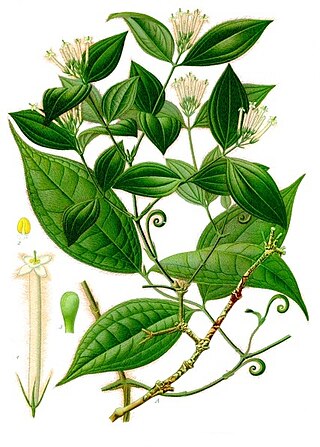
Strychnos is a genus of flowering plants, belonging to the family Loganiaceae. The genus includes about 100 accepted species of trees and lianas, and more than 200 that are as yet unresolved. The genus is widely distributed around the world's tropics and is noted for the presence of poisonous indole alkaloids in the roots, stems and leaves of various species. Among these alkaloids are the well-known and virulent poisons strychnine and curare.

Thistle is the common name of a group of flowering plants characterised by leaves with sharp prickles on the margins, mostly in the family Asteraceae. Prickles can also occur all over the plant – on the stem and on the flat parts of the leaves. These prickles are an adaptation that protects the plant from being eaten by herbivores. Typically, an involucre with a clasping shape similar to a cup or urn subtends each of a thistle's flower heads. The typically feathery pappus of a ripe thistle flower is known as thistle-down.

Chamaerops is a genus of flowering plants in the family Arecaceae. It contains only one species, Chamaerops humilis, variously called European fan palm or the Mediterranean dwarf palm. It is one of the most cold-hardy palms and is used in landscaping in temperate climates.

Ruellia humilis is a species of flowering plant in the family Acanthaceae. It is native to the eastern United States. It is grown as an ornamental plant.
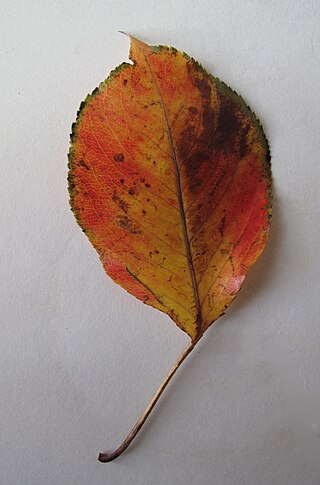
In botany, the petiole is the stalk that attaches the leaf blade to the stem. It is able to twist the leaf to face the sun, producing a characteristic foliage arrangement, and also optimizing its exposure to sunlight. Outgrowths appearing on each side of the petiole in some species are called stipules. The terms petiolate and apetiolate are applied respectively to leaves with and without petioles.

Allocasuarina humilis, commonly known as dwarf sheoak, is a species of flowering plant in the family Casuarinaceae and is endemic to the south-west of Western Australia. It is an erect or spreading dioecious or monoecious shrub that has its leaves reduced to scales in whorls of five to seven, the mature fruiting cones 12–22 mm (0.47–0.87 in) long containing winged seeds (samaras) 5–6 mm (0.20–0.24 in) long.

The Cardueae are a tribe of flowering plants in the daisy family (Asteraceae) and the subfamily Carduoideae. Most of them are commonly known as thistles; four of the best known genera are Carduus, Cynara, Cirsium, and Onopordum.
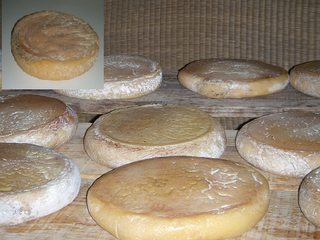
Queso de La Serena is a cheese made from Merino sheep milk in the comarca (district) of La Serena, in Extremadura, Spain. The pure sheep milk is curdled using a coagulant found in the pistils of cardoon. This ingredient lends a light bitterness to the otherwise slightly salty taste. It is aged for at least sixty days. When the cheese has a creamy consistency in the centre, it is traditionally eaten by slicing off the top and scooping out the inside with a spoon, and it is known as Torta de La Serena. If it is allowed to mature further it becomes harder, develops a stronger taste and is known as Queso de La Serena.

Cheese is a dairy product produced in a wide range of flavors, textures, and forms by coagulation of the milk protein casein. It comprises proteins and fat from milk. During production, milk is usually acidified and either the enzymes of rennet or bacterial enzymes with similar activity are added to cause the casein to coagulate. The solid curds are then separated from the liquid whey and pressed into finished cheese. Some cheeses have aromatic molds on the rind, the outer layer, or throughout.
Κ-casein, or kappa casein, is a mammalian milk protein involved in several important physiological processes. Chymosin splits K-casein into an insoluble peptide and water-soluble glycomacropeptide (GMP). GMP is responsible for an increased efficiency of digestion, prevention of neonate hypersensitivity to ingested proteins, and inhibition of gastric pathogens. The human gene for κ-casein is CSN3.
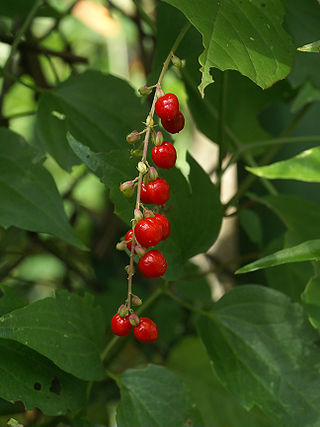
Rivina humilis is a species of flowering plant in the family Petiveriaceae. It was formerly placed in the pokeweed family, Phytolaccaceae. It can be found in the southern United States, the Caribbean, Central America, and tropical South America. Common names include pigeonberry, rougeplant, baby peppers, bloodberry, and coralito. The specific epithet means "dwarfish" or "lowly" in Latin, referring to the plant's short stature.
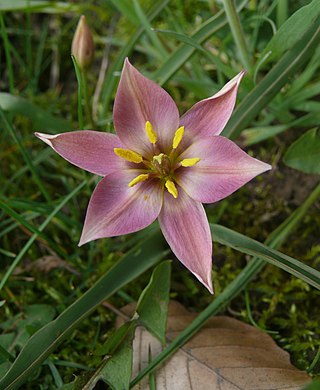
Tulipa humilis is a species of flowering plant in the lily family, found in Syria, Lebanon, Israel, Turkey, Iran, and the North Caucasus region of Russia. The flowers are pink with yellow centers. Its preferred habitat are rocky mountain slopes. It is known by several other names in horticulture.

Serpa cheese is a type of cheese from Serpa, Alentejo, Portugal. It has a Protected designation of origin (PDO) and is listed on the Ark of Taste.

In water treatment, coagulation and flocculation involve the addition of compounds that promote the clumping of fine floc into larger floc so that they can be more easily separated from the water. Coagulation is a chemical process that involves neutralization of charge whereas flocculation is a physical process and does not involve neutralization of charge. The coagulation-flocculation process can be used as a preliminary or intermediary step between other water or wastewater treatment processes like filtration and sedimentation. Iron and aluminium salts are the most widely used coagulants but salts of other metals such as titanium and zirconium have been found to be highly effective as well.

Iris humilis is a plant species in the genus Iris, it is also in the subgenus of Iris and in the Psammiris section. It is a rhizomatous perennial, with a wide distribution range from Europe to Russia to China, via Mongolia and Kazakhstan. It has sword-shaped leaves, a short stem and yellow flowers with an orange beard. It is cultivated as an ornamental plant in temperate regions.


















